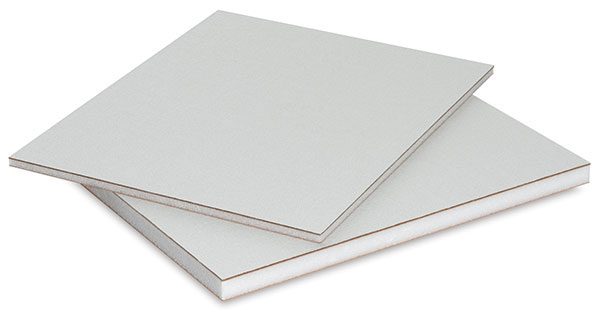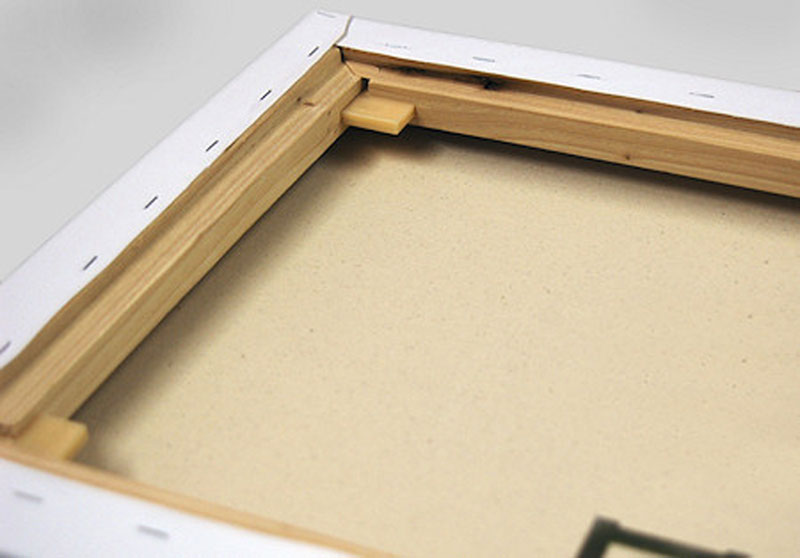I had a good discussion with a fellow artist at a recent art show reception. I asked if he preferred painting on stretched canvas or on canvas panels.
(Numerous art supply companies offer ready-made stretched canvas and canvas panels for artists. And many are good choices for a quality support at a fair price. However, this post is mainly for those of you artists who stretch your own canvas or make your own canvas panels.)
As you may know, I’ve been making my own linen panels for several years. (Click here to learn how.) But you might not be aware that I paint almost exclusively on panels. Here are eight reasons why.
- No loosening. Stretched canvas can become loose and require re-stretching. I’ve had this issue in the past when shipping paintings to a location with a different climate than mine — from Colorado to Florida. In fact, the artist I spoke with at the show had to tighten the stretched canvas on his show painting when he arrived at the event. Alternatively, canvas properly glued to a panel should not become loose.
- Less mounting difficulty. Stretched canvas can be difficult to mount squarely on the stretcher bars. And it takes some muscle to stretch it tightly. Canvas panels are easier to make and are square as long as the panel is cut squarely.
- No stretcher bars needed. Stretching canvas requires a supply of stretcher bars in the various lengths needed. Also, supporting crossbars are necessary for large canvases. Canvas panels require only canvas and panels large enough to make the needed sizes, plus glue.
-

Portrait of Marten Looten by Rembrandt (1632) in the LACMA Collection Less surface movement. The surface of stretched canvas can move with vibrations and changes in temperature. This can disturb the layers of paint over time and cause the paint to crack. The surface of a canvas panel is much more stable. For example, the pictured painting (detail) by Rembrandt in the LACMA collection was painted on a wood panel in 1632. The surface still looks brand new. Click here to see more close-ups of the painting.
- Portability. Canvas panels are more easily portable for plein air painting. Plus, light can’t shine through them from behind during an outdoor painting session as can happen with stretched canvas.
- Durability. Stretched canvas can be punctured fairly easily. I’ve done repair work on a few paintings (not mine) with holes in them that clients have brought to my gallery. (After one client had propped a painting against a wall, his large dog knocked it over and stepped through the canvas with his paw. Oops!) Canvas mounted on a panel can also be damaged, but I think needed repairs would be much more minor. And if Miracle Muck® glue was used when mounting, the canvas can be removed from a damaged panel and mounted onto another panel. (Miracle Muck® is heat activated.)
- Easier cropping. A canvas panel can be cropped more easily than a stretched canvas.
- Easier storage. Canvas panels take up less space than stretched canvases.

Back to the conversation with my fellow artist. He agreed with my points in favor of using panels. But he tends to use both types of supports for his work. Panels for smaller pieces painted outdoors and stretched canvases for larger studio paintings. By the end of our discussion, we also agreed on a few points in favor of stretched canvas.
- Spring-like feel. Stretched canvas has a spring to it that a panel lacks. One can feel the slight spring action of a stretched canvas against the brush.
- Larger sizes. For extremely large paintings, a large enough panel may not be available. I know Gatorfoam® panels and other similar products are available up to 60″ x 120.” I haven’t looked for sizes larger than that.
- Shipping unmounted. Unmounted paintings can be rolled up for shipping or storage and later stretched onto stretcher bars. This could be a big advantage and money saver when shipping large paintings overseas.
Do any of you have other reasons for or against the use of canvas panels?

25 Responses
Lisa Andrews
Thanks for the post, Dan. I only paint on linen, and mounting it on panel does ensure it will never sag or become loose if done correctly (or professionally). I have become used to the feel of painting on panel, and actually prefer it over the bounce of stretched canvas. It’s a pro vs. con thing. One suggestion for very large-scale works that are hard to ship is painting it on stretched linen, then roll and ship it, then have it mounted at its destination by a reputable framer or professional. This usually works best for a commercial client or one without a budget.
Austen
I much prefer working on canvas board as well, as I don’t really like the ‘give’ of stretched canvas… It’s been many years since I have made my own canvas board and I am not sure if I was taught the correct method. Do you have a youtube video or website that you can recommend that I can learn how to make these boards correctly from?
Dan Schultz
Sure thing — I wrote a post about it: https://www.danschultzfineart.com/make-plein-air-canvas-panels/
Dan Schultz
Thanks for the comment, Lisa. I obviously prefer the feel of painting on panels too. But I know many artists who like the feel of painting on stretched canvas. The feel of our materials is definitely of high importance to us artists! And I agree that the rolled-up shipping option is a great idea for those really large-scale works.
Judith Prager
Thanks for the very interesting post. What about framing, though. What kinds of frames do you use? I make my own frames, nailing pieces of painted lattice into the sides of my stretcher bars. This creates a nice, crisp black line around the edges without overlappint the painting, and is very economical and light. The buyer can easily replace the frame if they wish to. Thanks, Judith
Dan Schultz
Thank you for the compliment on my post, Judith. I buy frames from several different sources, depending on the quality I’m looking for. I try to have some more affordable options available in my gallery, plus some more expensive handmade options too. Some collectors want a full 22kt gold frame, while others want a more affordable one. You can see some of the frames I use if you wander through my website’s artwork section.
Coby Young
You guys say “thanks” a lot. I prefer to use canvas panels because it’s more stable and doesn’t bounce back..
gary Bradley
Dan,
re larger panels
Ive been using DIBOND for large work 4×8 ft sheets work great. Yo can cut them to any six=ze with knife. If you look around you can get a sheet for around $60.
I ve prepared then=m several ways.
Glue linen to the surface works fine
Gesso
but my favorite is to wait several layers of Gamblin oil prime,
in any event it is a very effective approach
Stefan
Hi Dan and everyone there,
I have been using Dibond as a carrier, too, as well as Gatorfoam. I think that linen bonding on Gatorfoam or any other board is limited to smaller or medium sizes, because it’s getting harder to bond the linen without any curling the larger the size is. Now I give it a try to bond Arches oil paper on Dibond using the Golden soft gel, which works excellently. The oil paper is stiffer than canvas so it’s easier to get it fixed on a board without any curling or remaining air bubbles. Since the oil paper is available in rolls I am going to try larger sizes in future, which is my main objective using the oil paper. Are there any guys who are experienced in that particular issue, too? Or do you Dan have any experience making boards in that way?
But great issue to talk about!
Stef
Scott Gellatly
Thank you, Dan, for this important advice to painters and collectors. This is a drum we’ve been pounding for years…it’s terrific to see quality painters like yourself sharing this terrific info!
Cheers,
Scott
Dan Schultz
Good to hear about your Dibond experience, Gary and Stefan — I’ve not tried that. Stefan, your oil paper idea sounds interesting too.
Linen Snobbery (Linen vs. Cotton Canvas)
[…] I stretched it onto stretcher bars of varying sizes. Now I prefer to glue it down on panels. (Click here to read why. And if you would like to learn how to make your own linen panels, click here to see my […]
Moiz N Haque,
Why glue the canvas on the board! Instead cover the front of the board with canvas and glue the folded edges of canvas on the back of the panel! What I do is to frame the panel with wooden batons, then nail the canvas over the frame! ( or better use screws & washers to secure the canvas) Use good quality of marine grade 8 mm plywood & further paint the panel & frame with gesso on all sides! In this case, you can remove the painting from the panel if need!
Dan Schultz
The glue that I use (Miracle Muck) is heat activated, which allows the canvas to be removed from the panel if needed. It’s a pretty easy process that I’ve done a few times, but rarely need to.
Deb Lily
Thanks. This post is exactly what I needed.
Canvas Panel - Stretched Canvas vs. Canvas Panels - DanSchultzFineArt
[…] Stretched Canvas vs. Canvas Panels – DanSchultzFineArt […]
Kathy Gage
I also use a stretched canvas but I have used the panels also. You are right about them moving and easy to damage and the light does shine through them. I never thought about it until now. Beside the flat canvas fit better in a frame work too. Thanks for the information.
What Is Canvas Stretching? – Erickkasysavane
[…] Canvas panels are easier to make and are square as long as the panel is cut squarely. No stretcher bars needed. Stretching canvas requires a supply of stretcher bars in the various lengths needed. Canvas panels require only canvas and panels large enough to make the needed sizes, plus glue. via […]
San
I’m glad I found this article. I’m just about to start out as an artist and I was wondering if I should use stretched canvas or panels and this really helped me to decide.
Ruth Alstot
I am not a pro so I just buy the panels from my local art store. I’ve done painting on both kinds and I just prefer the panels. But I recently heard something that has me concerned…I heard that the cardboard under the canvas “sucks the oil right out of your paint”. That can’t be good??? Have you heard that?
Dan Schultz
Hi Ruth,
I haven’t heard it put like that, but cheaper canvases can definitely absorb your paint. I don’t think the cardboard has anything to do with it. It has more to do with how well (or poorly) the canvas has been primed. If you find that the canvas feels like it’s absorbing your paint, just give your unused panels a coat or two of gesso or oil primer. This will seal the canvas better and keep the paint on the surface where it belongs. This is one of the reasons I prefer linen to cotton canvas. Linen panels seem to be sealed better. See the article below if you haven’t yet. Happy painting!
https://www.danschultzfineart.com/linen-canvas-vs-cotton-canvas/
Frank DiPietro
On other sites they say that canvas panels last a few decades whereas stretched canvases last 100+ years.
Do you agree with that
Dan Schultz
I don’t have any reason to believe that canvas panels won’t last just as well as stretched canvases. In fact, a quick Google search led me to this article, with a photo of a painting on canvas panel from 1908. Looks like it’s in pretty good shape. I’m sure there are older canvas panels out there too. We should probably just stay away from cheaply made canvas panels. https://www.artfixdaily.com/artwire/release/6556-the-tides-of-provincetown-pivotal-years-in-america’s-oldest-con
What is pre stretched canvas? - Wiki-Flag
[…] Are stretched canvases better? […]
Canvas Panel vs Stretched Canvas: Pros and Cons Revealed -
[…] more vigorous painting techniques or mixed media applications. Ultimately, the choice between stretched canvas and canvas panels comes down to the artist’s individual style and […]